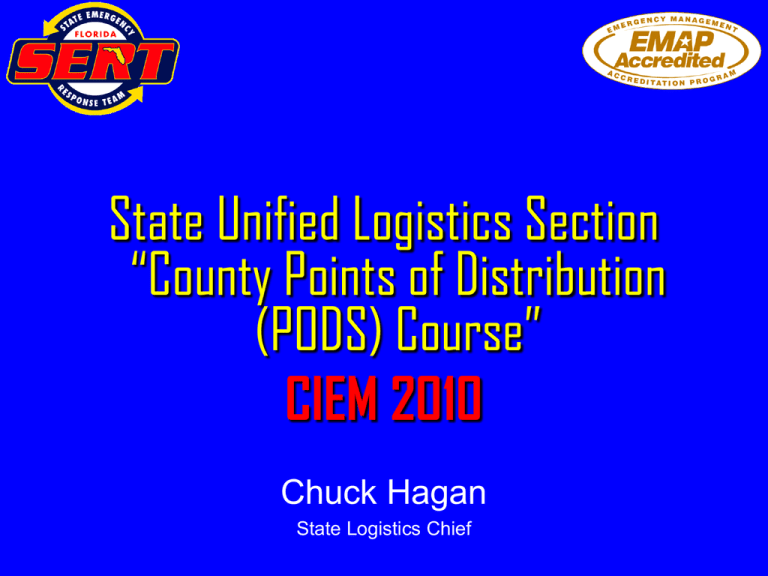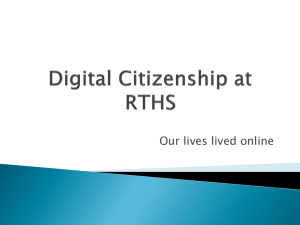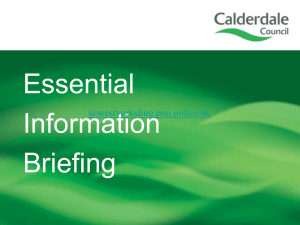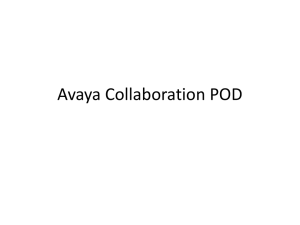County Points Of Distribution (POD)
advertisement

• State Unified Logistics Section “County Points of Distribution (PODS) Course” CIEM 2010 Chuck Hagan State Logistics Chief State Unified Logistics • Comprised of professional logisticians from state, federal and voluntary agencies having mission support requirements contributing year round – – – – Planning, modeling and forecasting Response operations Recovery support Mitigation initiatives • Extensive State Logistics Planning in coordination with federal, state, county and voluntary agencies, and our business partners is an ongoing process • Other states as well as FEMA have evaluated the Florida Logistics Plan, processes, forecast models and systems and are adopting many elements. • FEMA adopted the Florida County Points of Distribution course and released a scaled down version for other states. Pre Event Planning • Scenario Planning – Anticipating Requirements • Computer models developed by the State and adopted by FEMA and the US Army Corps of Engineers • Mobilization Areas • Logistics Staging Areas – State, Federal and County • • • • Forward Operations Bases Resource and Commodity Identification Vendor Agreements for “Turn Key” Operations Logistics Section Support Staff – – – – Florida Division of Forestry Florida National Guard State and voluntary agency personnel Business Partners Field Sites – State MobArea • State Mobilization Areas (MobArea) – Pre-staging of resources outside of a potential impact areas until post event – Resources are then moved forward to one or more State Logistics Staging Areas – MobAreas can either close or remain open as a rear area in order to accept a backlog of resources Field Sites – State Mobilization Area – Location • • • • On or Near Major Highway (required) Near Commercial or Military Airport / Field (desired) Near rail spur / head (desired) Fenced or otherwise secure area – Covered Area • • • • 50,000 + square feet 4 each Loading Docks minimum Administrative area POTS Communications available – Hard Stand Area • 800,000 square feet (20 Acres) State LSAs State LSA Typical Resources • Prime Power Task Forces • Bulk Relief Supplies – USDA Food Commodities • Hydrological Relocation – Wholesale Food Service Task Force Purveyors • Search & Rescue Teams • Produce, Meats, Dairy, (USaR) Bakery, Paper • Medical Teams – Potable Water and Ice • Power Restoration Crews – Plastic Sheeting • Debris Removal Crews (Visqueen©) • Mechanized Maintenance – New Clothing (sized) Services – Cleanup Supplies • Refueling Services – Shelter Supplies – Building Materials – Medical Supplies Type I State LSA – Location • • • • Near Major Highway On-site Commercial or Military Airport / Field On-site rail spur / head (desired) Fenced or otherwise secure area – Covered Area • • • • • 150,000 + square feet 8 each Loading Docks minimum Administrative area POTS Communications available T-1 Lines required for INET and Video Conference – Hard Stand Area • 800,000 square feet (20 Acres) Minimum PLUS • Two Helicopter Landing Zones (180,000 Square Feet) – Worker Support (Base Camps) • Billeting Areas & Food Service (desired) Type I-A State LSA Strategic National Stockpile (SNS) – Location • Near Major Highway • On-site Commercial or Military Airport / Field – Cargo 747 Capable • K-Loader • Double Fenced Secure Area – Covered Area • 50,000 + square feet General Use Warehouse PLUS • 20,000 + square feet, Air Conditioned Medical / Pharmaceutical Warehouse (Tier II Security Zone) • 6 each Loading Docks minimum • Administrative area • POTS Communications available • T-1 Lines required for INET and Video Conference – Hard Stand Area • 500,000 square feet (12 Acres) Minimum PLUS • Two Helicopter Landing Zones (180,000 Square Feet) – Worker Support (Base Camps) • Billeting Areas & Food Service (desired) Type II State LSA – Location • • • • On or Near Major Highway Near Commercial or Military Airport / Field (Fixed Wing) Rotor wing LZ on-site On-site rail spur / head desired – Covered Area • • • • • 100,000 + square feet 6 each Loading Docks minimum Administrative area POTS Communications available T-1 Lines required for INET and Video Conference – Hard Stand Area • 500,000 square feet (12 Acres ) minimum PLUS • Two Helicopter Landing Zones (180,000 Square Feet) – Worker Support (Base Camps) • Billeting Areas & Food Service (desired) Forward Operations Base • FOB’s are established as assembly areas to support small quick response teams such as: – – – – – Urban Search and Rescue Teams (USaR) Area Reconnaissance Teams (RECON) Damage Assessment Teams Disaster Medical Assistance Teams (DMAT) Disaster Mortuary Teams (DMORT) • Only essential services are provided to support teams: – Food and Water – Fuels – Health & Sanitation • FOB’s are NOT long term sites, and are typically operated only for a few days Base Camps • NIMS Typing – I = 1000 Persons - fixed – II = 750 Persons – fixed – III = 500 Persons – fixed – IV = 250 Persons – fixed – V = 150 Persons – mobile – VI = 50 Persons – mobile • 2006 Capability – 10 NIMS Type I Camps – 2 NIMS Type V Mobile Camps County Staging Areas (CSA) • The State prefers to “direct ship” assets to the “Point Of End Use” as requested on the Mission Assignment submitted by a county. • Municipalities must request resources through their County EOC. • Counties who elect to establish one or more County Staging Areas (CSA), to self-manage resources contracted for directly by the County, must be able to do so on their own. – Should not request FLNG or DoF IMT assistance since their personnel resources are limited! – MUST NOT contact LOCAL DoF or FLNG Armory for support! • All requests MUST come through the SEOC! County Staging Areas (CSA) • County Staging Areas (CSA) must be pre-identified, and capable of receiving resources within 24-hours post event. • Counties must provide sites with at least one fork lift and two pallet jacks to facilitate the immediate offloading of resources. – The State will be able to assign additional MHE after 72hours • All resource requests for State logistics support assets will be made through the State EOC, Logistics Section. County Management of Commodities • If counties elect to have all commodities shipped to their CSA versus the PODS, they MUST conform to state standards: – Have WATER on POD sites, and DISTRIBUTING within the FIRST 24-HOURS! – Fully Staff their CSA and PODS • If we do not have POD sites 96-hours PRIOR to landfall, we cannot task the FLNG to staff the sites. CSA Site Requirements Minimum Site Requirements: • 250,000 sq. ft. (5 AC) outside storage/parking. • 40-50,000 sq. ft. covered/inside storage. • Loading dock capability. • Telephone/communications service and fuel support. • Office, computer, communications, and loading equipment will be required. • One forklift and two pallet jacks, minimum on site. • A 300’ X 300’ designated area, clear of wires, for a helicopter landing zone. (LZ) • Secure Perimeter Area Federal Prepositioned Logistics Centers • Pre designated full time federal warehouse and logistics centers across the United States • Closest TLC’s are Atlanta, GA – Fort Gilliam (Water, MRE’s, GENSETS, Mobile DRC’s, etc.) and Thomasville, GA (ICE) • Supports entire regional areas but can be shipped anywhere in CONUS or OCONUS Federal Incident Support Bases (ISB) • Established by FEMA WITHIN an affected state pre-event • Forward area for the staging of emergency resources – Commodities (Water, Ice, MRE’s, Tarps) – Hard Assets (GENSETS, Mobile DRC’s) – Teams (USaR, DMAT, DMORT etc.) • FLORIDA FOSA’s – NAS JAX – Homestead ARB – NAS Pensacola – Sauffley Field “County Points of Distribution (PODS) Logistics Philosophy • Changing Outcomes – – – – “It’s What We Do!” Focus on the outcome you want Plan the mission to achieve that outcome Execute the Plan Monitor the outcome and adjust • Push versus Pull Logistics “It’s How We Work!” – It’s better to have too much than too little – Push resources into the affected areas. Do not wait for requests. Communications are down, responders impacted – A quick overwhelming response in the initial phase IS better than a methodical response. • Does not release us from planning! – If you wait until you have all the facts, it becomes harder to change the outcome. • We work with 70% solutions! Adjusting Resources • Post event actions are adjusted once further intelligence has been obtained – Actual resource requirements – Burn Rates (how much of an item is actually being consumed) based on actual distribution through put • Par levels are then set for each resource to insure that critical resource levels do not fall below 1½ days of inventory • Resource ordering is then based on these projections – – – – – – Changing Outcomes! Ability to DISTRIBUTE resources Power restoration Emergency NEED not WANT Degree of damage and residential occupancy Social Services becoming available Hurricane Wilma • 96 County Points of Distribution (POD) Across 13 Counties • Water – $1.51 per gallon = $7,172.00 per truck + Transport – 1,701 Truck Loads – 8,079,750 Gallons = $12,199,572.00 • Food – – 556 Truck Loads = – 11,676 Shelf Stable Meals • Ice – $ $3,367,980.00 .20 per pound = $8,000.00 per truck + Transport – 1,398 Truck Loads = – 55,920,000 Pounds (27,960 Tons) $11,184,000.00 • Tarps - – 89 Truck Loads = $7,073,260.00 – 311,500 Individual Self Help Tarps • TOTAL: 3,744 Trucks of Commodities • Commodities Costs: $33,824,812.00 • Shipping Costs: $ 5,241,600.00 + detention time of about $ 8,690,000.00 • TOTAL COSTS: $47,756,412.00 • Estimated Population Served: 4,863,633 County Points Of Distribution (POD) • In the immediate aftermath of an event, POD’s are the first line of relief operations to affected clients. • POD sites will be used for the purpose of receiving and distributing bulk emergency relief supplies such as water, ice, food and tarps within the first 24-96 hours after an event. • Sites are to be included in the County CEMP, with copies forwarded to FDEM. • PODS “support” not “supplant” community resources – We rely on community resources (retail sector) to provide essential resources to the extent possible. – We make sure resources are “available” and not necessarily free. County Points Of Distribution (POD) • Local Distribution and Receiving Sites – In 2004 and 2005, counties that had pre-identified their primary receiving site/county LSA and public distribution sites, along with staffing requirements, were able to manage in-bound resources faster and easier. • MODEL: – The average site can distribute commodities to 2,800 cars or 8,960 persons per day based on models. • 72 PODS maximum in first 24 hours • Each Type I Site requires 88 workers KEY POINTS • PODS are designed for major and catastrophic or near catastrophic events • PODS typically operate only for the first 3-7 days of an event. • PODS are NEVER collocated with commercial businesses in operation such as supermarkets, WalMarts etc. • Counties are responsible for coordinating locally with principal retail businesses who intend to reopen to sell commodities to avoid site collocation. • Alternative means of distribution such as Comfort Stations, and mobile distribution must also be planned for by the county. • Support to all facilities such as shelters and feeding sites must also be a factor of distribution KEY POINTS • Counties must pre identify all POD locations to FDEM pre hurricane season in priority order. • POD site locations must be confirmed with the SEOC at least 72-hours prior to landfall • Shipments to EITHER a county CSA or DIRECT to PODS MUST be pre negotiated with the State Logistics Section pre hurricane season • Counties must be able to assume staffing and management of POD’s after 72-hours • Counties must provide security, traffic management and assets (cones, barricades etc.) to the extent possible, or request additional assets through the SEOC • Counties must provide local communications to the extent possible, or request additional assets through the SEOC State Support • The State will push WATER to each county pre identified POD within the first 24-hours post event. – Ice, food and other commodities will be provided after 4872 hours depending upon the assessed need of the operation. • The State will also provide minimum staffing for each POD for the first 72-hours • The State will provide at least one forklift and two pallet jacks to each site, followed within 48-72 hours, with porta-potties and dumpsters • The State will establish one or more State Logistics Staging Areas (LSA) within 24-36 hours to support county operations. • Initial assets will be pushed out from State Mobilization Areas (MOBAREA) as soon as it is safe. County Responsibility • Counties must be able to assume management of POD’s after 72-hours – National Guard and Division of Forestry assets will most likely NOT be available after the first 72- hours, due to other mission priorities • Counties must provide traffic management assets (cones, barricades etc.) to the extent possible, or request additional assets through the SEOC • Counties must provide site security, traffic control and local communications to the extent possible, or request additional assets through the SEOC Staffing of PODs • Staffing is dependent upon the pre event arrangements made between each county and the State Unified Logistics Section. – The State can mission task the FLNG for 20 personnel per site to initially establish a POD and manage operations for the first 72-hours – Counties can assume full responsibility for POD staffing and management from the first day and forward Staffing of PODs • Where the State is providing FLNG personnel for the first 72hours, counties are responsible for providing additional staff as available through this first 72-hours, and then assume full responsibility for staffing and management of PODs from 72hours to closure. • Sources of staff can come from: – – – – – – County / municipal personnel Voluntary Agencies (VolAgs) County contracted personnel CERT Civic Organizations Church Groups • Do NOT request a mission tasking for additional FLNG, DoF or other state personnel to manage PODs. – Staffing is a county responsibility Staffing PODs • Each POD must have at least one manager per shift • POD operations are very tiring – Staff must be adequate to allow for breaks every 30 minutes during summer months – Cooling tent must be in place with fan and iced water for staff • A Safety Officer MUST be assigned to EACH lane of loading operations • Personnel must wear reflective or high visibility vests • Security / Law Enforcement must be assigned to critical points and traffic control Site Security • Counties are responsible for assigning law enforcement and traffic control personnel to each POD. • The FLNG deployed for the purpose of establishing a POD, will NOT perform any form of security mission at PODS. • Counties are responsible for assigning adequate law enforcement personnel to secure the site on a 24-hour basis as well as traffic management and control. • If the county is short on law enforcement resources, they can request support through the SEOC through normal channels. • The county may also wish to contract for private security for these sites. • Counties must also provide for two-way communications between the PODs and the county EOC. • Counties must provide traffic management resources – Cones, barricades, signs County Points Of Distribution (POD) • Preplan your sites – U.S. 2004 Census Track Maps – Define the AOR based on the Type of POD – Pre-Event: Determine the number of PODS based on the projected impact area. – Post-Event: Activate those PODS in affected jurisdictions. COUNTY POD LOCATIONS TYPE I POD TYPE II POD TYPE III POD COUNTY STAGING AREA The following web site provides census track map data. http://www.census.gov/census 2000/states/fl.html POD Projection Models have been developed in MS Excel and are available via e-mail from the FDEM Logistics Section Selecting POD Locations • The placement of PODS in a community must be a well thought out process. • Since 2004, many major supermarket and home improvement chains have made a corporate commitment to have their stores open within the first 24-hours after an event. • Most have, or are in the process of, installing emergency generators at their stores, or availlable for assignment in order to reopen as soon as possible. Selecting POD Locations • As such, it is counter productive to place a POD across the street from an open Wal-Mart, Publix, Albertsons etc. that has water, food and ice available for sale. • The objective of the state is to ensure that resources are “available” to a community. This does not mean it has to be FREE, just available. • The same goes for distributing tarps in front of a Home Depot or Lowes. Selecting POD Locations • Counties should focus on placing PODS in outlying areas where these types of stores are not located inorder to insure that resources are available in those areas. • FDEM is in the process of geo-coding the locations of major chains in the state, and will send this information to each county as a planning tool, but in the interim, counties should meet with the store managers of these major chains to determine each stores re-opening policy. • FDEM has requested that corporate offices of major chains to collaborate with each County EM Office for this purpose so do not be surprised if you get calls on this matter. POD Site Assessment Process • County PODS are critical to the success of providing immediate relief to affected citizens; therefore the strategic placement of PODs around the county must take several factors into consideration. • First, population base; each site must serve the resident community in which it is located. • Referring to the three POD site plans, a county may require one or more Type I POD’s in a densely populated area, while Type II and Type III sites would serve outlying areas and special communities. • Each POD has a projected Area Of Responsibility (AOR). Counties should refer to their census track and dot-density maps to determine population bases, then match the POD Types accordingly. • More than one Type I site may be required in a given community due to the second factor. POD Site Assessment Process • Second, geography and travel distance. In “Blue Sky” planning meetings, a distance of 5—10 miles may not seem like a great distance, but in a post disaster event, it may be impossible to travel these distances due to debris, blocked traffic routes, flooding, damaged bridges or other impediments that would restrict the public from accessing a site. • For this reason, multiple POD’s of varying Type sizes, should be planned for based on known flood planes, bridges, canopy roads, and other factors. Sites should be placed on major roads that allow four lanes where possible since at least 1 lane must be dedicated for POD traffic in each direction. POD Site Assessment Process • Third, remote and special communities. One cannot assume that the public will travel far from their homes to access resources. • Type III POD’s should be planned for in small communities, large sub-division development tracks, migrant worker camps, Indian reservations, low income areas, and barrier islands. • Comfort Stations and feeding kitchens are NEVER collocated with PODS, so that traffic may flow at maximum throughput. POD Location List • PODS MUST BE PRE IDENTIFIED BY THE COUNTY AND THE LIST PROVIDED TO THE STATE LOGISTICS SECTION BY 1 JUNE EACH YEAR. • The final selection of which PODs will be opened for a specific event must be provided by the county to the State EOC Logistics Section no later than 96hours PRIOR to hurricane landfall. • Post landfall, identified sites will be inspected by FLNG personnel assigned to the POD and adjustments made in coordination with the county EOC in the event the site cannot be used due to debris, flooding, road impediments or other factors. POD Characteristics Hours of Operation 24-hours 0700 – 1800 = Public Distribution 1900 – 0600 = Restocking (Note deliveries made between 2300 – 0400 Hrs) Location •PODS will NOT be established within 5-miles of an open retailer selling product •Designed to serve vehicle traffic. A separate area must be established to serve occasional walk-up pedestrians. •Large open commercial areas preferred with adequate road network to support multiple lances •Distribution point will be clear of debris •Staff cooling tents will be erected •Public encouraged to use a POD close to where they live Size Refer to POD Models • TYPE I = 125,000 Square Feet • TYPE II = 75,000 Square Feet • TYPE III = 45,000 Square Feet Accessibility •Unloading area for supply trucks away from pedestrian/vehicle flow •Layout supports efficient flow of pedestrians/vehicles •Accessible from evacuation routes, and truck routes Security • Responsible for establishing a safe flow to, within and exiting the site • Resolve any public concerns or issues that may arise Other Requirements • Site and surrounding roadways should be cleared of debris and other objects that may pose a hazard to staff (e.g. downed power lines) • Sufficient dumpster capacity - Dumpsters will be provided to each site • Availability of restrooms – Porta Potties will be delivered to the site Opening PODs • Once PODs are open, they MUST remain open for the first 72-hours due to the level of resources, personnel and equipment that must be allocated and deployed in support of PODs. • After 72-hours, POD locations can be jointly evaluated and moved, closed or new PODs established in the county. • PODs take at least 24-hours to change or establish, so all location changes must have at least 36-hours advance notice. Mobile Distribution • Counties should also plan for mixed load mobile distribution to isolated farms and small plantations, nursing homes, adult living facilities, the homebound and elderly, trailer and mobile home parks, special facilities such as prisons, work camps, and isolated marinas that have fewer than 100 people. • Agencies such as the American Red Cross and Salvation Army may have the ability to conduct limited mobile distribution to these areas while conducting feeding operations, but each county must address how they will conduct mobile operations in advance based on their demographics. State of Florida County Point Of Distribution (POD) Organizational Structure COUNTY EOC LOGISTICS DESK COUNTY POD MANAGER COUNTY POD MANAGER SAFETY OFFICER COMMUNITY RELATIONS MANAGER COMMUNITY RELATIONS STAFF (*) Refer to POD Type For staffing levels - Type I - Type II - Type III COUNTY POD MANAGER SECURITY OPERATIONS DAY SHIFT TEAM LEADER FORKLIFT OPERATORS (*) LABOR FORCE (*) PALLET JACK OPERATORS(*) LOADING POINTS (*) BACK-UP LOADING POINTS (*) LOGISTICS NIGHT SHIFT TEAM LEADER FORKLIFT OPERATORS (*) LABOR FORCE (*) FOOD UNIT LEADER INVENTORY Type I County Point Of Distribution (POD) 250 +/- Feet 500 +/- Feet 125,000 Square Feet depending upon site plan and traffic flow requirements Type I County Point Of Distribution (POD) Type II County Point Of Distribution (POD) 75,000 Square Feet depending upon site plan and traffic flow requirements 250 +/- Feet 300 +/- Feet Type II County Point Of Distribution (POD) Type III County Point Of Distribution (POD) 45,000 Square Feet depending upon site plan and traffic flow requirements 150 +/- Feet 300 +/- Feet Type III County Point Of Distribution (POD) POD Operations • PODs Operate to the public only during daylight hours • PODs are restocked during late evening hours, typically from 2300 to 0500 Hrs. • A Traffic Management Plan must be developed for each site. – One-way traffic through the site – Clear signs or cones for drivers to follow – Law Enforcement must be present to resolve any “issues” that develop with drivers. POD staff should never get into an argument with clients. Hours of Operation • POD's operate 24 hours per day – Public Distribution runs only during daylight hours for security and safety reasons. – All restocking and in-bound trucks deliver at night • Daytime deliveries will only be made in emergency situations, because this will stop all distribution operations while trucks arrive and are off-loaded. POD Operations • Currently we do not ask for identification of clients going to a POD. – Legislative bill presently would make it a Second Degree Misdemeanor to unlawfully obtain disaster relief supplies. – Signs will be posted in PODs clearly stating this law if passed this session • We will NEVER discriminate! All clients are entitled to relief supplies regardless of how they may appear. – The State is trying to reduce the issues during Hurricane Katrina of abuse by unaffected clients or the resale of commodities, although we do have a law prohibiting resale of disaster relief supplies. Distribution of Commodities It is not uncommon for the State Logistics Section to push out 100% of available resources on day-1 with no back up until additional commodities arrive later in the evening. • As such, we cannot permit PODs to over distribute early and run out later in the day. • Personnel MUST be instructed not to “fill the trunk” with commodities until a strong pipeline can be assured. Distribution of Commodities • County EOC’s will be advised when full distribution can commence at PODs. • Initial distribution must be limited to the following in the first 72-hour period of operations: – 1 Gallon of water per person, per day (4 Liters) – 8 pounds of ice per person, per day ( 1 Bag) IF APPROVED – 2 Emergency Food Rations (MRE’s, Shelf-Stable Meal or equivalent) per person, per day (if available and required) IF APPROVED POD Operations • PODs must maintain communications with the respective county EOC. • Reports will be filed at least twice each day at each POD prior to opening and at the end of each day indicating the – Level of commodities – Shipments received overnight by truck and shipment number (bar code) – Staffing and support on site – Critical concerns – Quantity distributed for the operational period TYPE III POD Bulk Distribution Calculations • WATER: – 4 liters or 1 gal per person (3.79 liters per gal) • 1 Case of 16.9 oz bottles = 3 gallons – 18,000 liters or 4,750 gal per truck – 20 Pallets per Truck, 900 liters per Pallet, 237 gal per Pallet, 1900 # per pallet – 212 Trucks = 1 Million Gal (1 Million persons) • ICE: – 8# (1bag) per person per day – 40,000 # per Truck Load – 20 Pallets per Truck, 2000# per Pallet, 250 – 8# bags per pallet, 5,000 Bags per Truck – 25 Trucks = 1 million # – 200 Trucks = 1 Million Persons • Shelf Stable Meals or MRE’s – 1 Case Shelf Stable Meals (3 meals per case) per person, per day – OR . . . 2 MRE’s per person, per day – 2,880 Cases per Truck Load / 34,560 Meals – 20 Pallets per Truck Load, 144 Cases per pallet, 12 Meals per Case – 58 Truck Loads = 2 Million Meals (1 Million Persons) Burn Rates • On average, the follow are the calculated distribution model for each commodity. – 1 truck of water (4,750 gal) = 1,500 vehicles* – 1 truck of ice (42,249 lbs) = 1,666 vehicles* – 1 truck of Shelf Stable Meals (13,600 3 Meal Cases) = 4,290 vehicles* – 1 truck of MRE’s (20,976 ea) = 3,624 vehicles* – 1 truck of tarps (4,400 ea) = 4,400 vehicles* – *Vehicles represent 3.17 persons per household according to U.S. Census data. POD and Commodity Model • MS Excel POD Projection Worksheet • Forecasts the number of PODS required based on a projected affected population and confidence level of the percentage of population that will require commodities. – Not always 100% due to other resources available • Markets open • VolAg distribution etc. – C:\Documents and Settings\desktop_team\Desktop\FL POD FORECAST MODEL.xls Resource Modeling - Water • People without power 0.6 = People requiring water • People requiring water 1 gallon/day = One day water requirement Sample Water Model: The following table shows how the number of water needed for 200,000 households (600,000 People) for the first 24 days. Assumptions • Number of households w/o power:……………………………… 200,000 • Number of people w/o power (households 3)………………… 600,000 • Number of people requiring water (people w/o power 0.6)…. 360,000 • D+1 gal. required (1 gallon people requiring water)…...… 360,000 gallons GALLONS OF WATER 60% Power Returned 400,000 90% Power Returned 320,000 240,000 Water 160,000 80,000 0 0 8 16 24 DAYS Warning: Do not base projects on this model only, but also take into consideration other factors to include distribution capabilities, other sources of water (local sources, state and volunteer efforts, etc.), and power restoration capabilities. Resource Modeling - Ice • People without power 0.6 = People requiring ice • People requiring ice 8 lbs/2000 lbs = One day ice requirement (tons) Sample Ice Model: The following table shows the amount of ice needed for 200,000 households (600,000 people) for the first 24 days. Assumptions • Number of households w/o power:……………………………. .200,000 • Number of people w/o power (households 3)………………... 600,000 • Number of people requiring ice (people w/o power 0.6)…….. 360,000 • D+1 Tons required (8 lbs. people requiring ice/ 2,000 lbs)…1,440 tons 60% Power Returned 60% Pwr Restored TONS OF ICE 1,500 90% Power Returned 1,200 900 90% Pwr Restored 600 ICE 300 0 0 8 DAYS 16 24 Warning: Do not base projects on this model only, but also take into consideration other factors to include distribution capabilities, other sources of ice (local sources, state and volunteer efforts, etc.), and power restoration capabilities. RECAP • PODS are designed for catastrophic or near catastrophic events • PODS typically operate only for the first 3-7 days of an event. • PODS are NEVER collocated with commercial businesses in operation such as supermarkets, Wal-Marts etc. • Counties are responsible for coordinating locally with principal retail businesses who intend to reopen to sell commodities to avoid site collocation . • Alternative means of distribution such as Comfort Stations, and mobile distribution must also be planned for by the county. • Support to all facilities such as shelters and feeding sites must also be a factor of distribution RECAP • Counties must pre identify all POD locations to FDEM pre hurricane season in priority order. • POD site locations must be confirmed with the SEOC at least 72-hours prior to landfall • Shipments to EITHER a county CSA or DIRECT to PODS MUST be pre negotiated with the State Logistics Section pre hurricane season • Counties must be able to assume staffing and management of POD’s after 72-hours • Counties must provide security, traffic management and assets (cones, barricades etc.) to the extent possible, or request additional assets through the SEOC • Counties must provide local communications to the extent possible, or request additional assets through the SEOC QUESTIONS ?????







